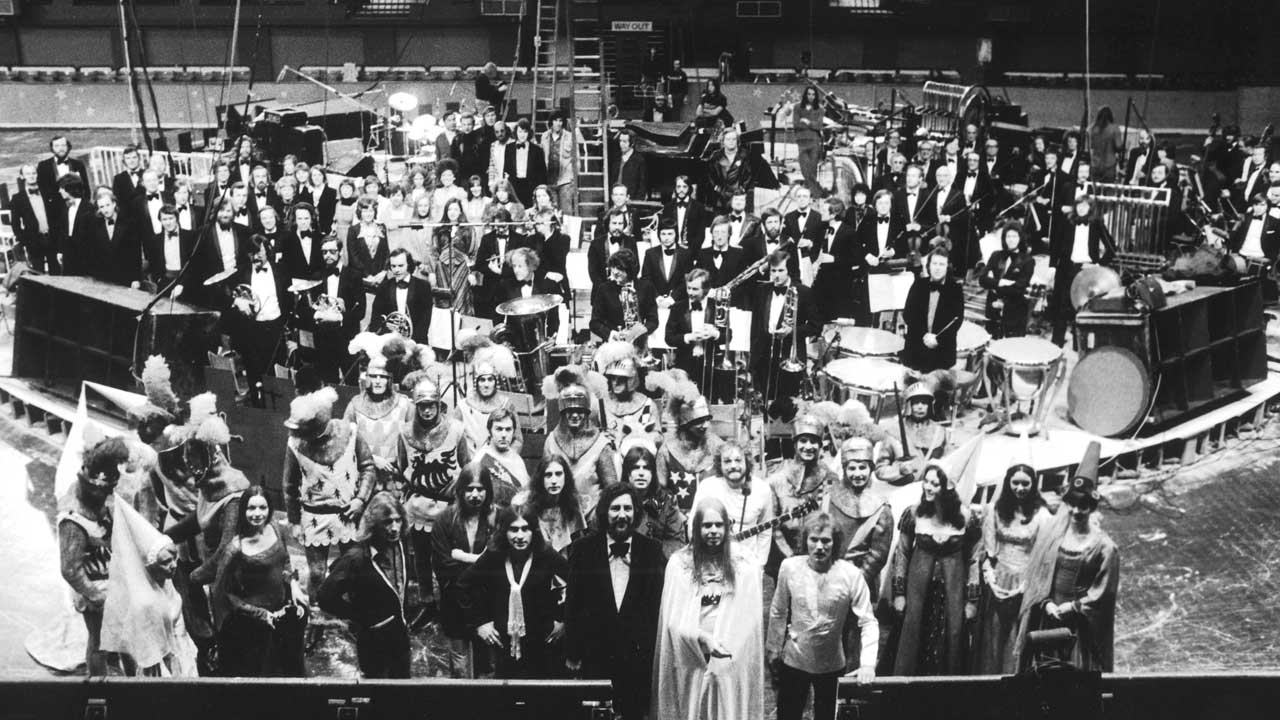The crazed story of rock's ultimate folly: Rick Wakeman and King Arthur... on ice
The live version of Rick Wakeman's The Myths & Legends Of King Arthur & The Knights Of The Round Table was spectacular and chaotic. It also sent Wakeman’s career into a near-terminal nosedive

Mid-70s progressive rock has a reputation for pomposity, grandiosity and excess all areas. Many of the name acts of the time were guilty as charged, but it is generally held to be true that, with one particular show, one particular artist went one further and one dafter than anyone else: The Myths & Legends Of King Arthur & The Knights Of The Round Table, as presented over three consecutive nights in July 1975 at the Wembley Empire Pool (now Wembley Arena) by Rick Wakeman.
In addition to the flaxen-haired wizard of the ivories himself, resplendent in Merlin cape and pointy hat – there, on his podium, ’twixt keyboard stacks in the custom-built castle – the show, like the recently released album, featured his six-strong band the English Rock Ensemble (ERE), narrator Terry Taplin, conductor David Measham and the 46-strong New World Symphony Orchestra (NWSO), chorusmaster Guy Protheroe and the 46-strong English Chamber Choir (ECC), and the eight-strong Nottingham Festival vocal group.
And to take the performing personnel up to 130 or so, what the programme notes described as ‘a host of ice stars’.
Yes, ice stars.
King Arthur… was presented on ice. But you knew that. Because, as already hinted, the Wembley ice shows are to Wakeman and prog what decapitated bats are to Ozzy and heavy metal. They are locked into the public consciousness, part of rock mythology.
We look back on all rock’s milestones through a series of distorting lenses, but the two lenses responsible for doing the most distorting with regard to King Arthur… at Wembley are punk rock and Spinal Tap. The overwhelming consensus was: ‘Ice spectacular? What a load of bollocks.’

The entire King Arthur… on ice episode was indeed a spectacular rock folly. It put ‘X-rated’ into Excalibur, and it sent Wakeman’s career into a near-terminal nosedive.
Sign up below to get the latest from Classic Rock, plus exclusive special offers, direct to your inbox!
“We were always deadly serious about the music, but not much else,” says ERE bassist Roger Newell. “The idea of mixing skating with rock was another ‘first’, but it was also hilarious…”
“I wanted to do the King Arthur… show at Wembley,” recalls Rick. “And they said: ‘You can’t, there’s an ice rink installed.’ I said: ‘Sod it, I’ll do it on ice.’”
“The ice was needed for a spectacular immediately after our appearance,” confirms Newell. “As the iced area was like a barrier between the audience and the band platform, something had to happen there…”
If not exactly improvised, then, the styling and choreography of the ice stars’ contribution was inevitably something of an afterthought. When Wakeman’s manager Brian Lane asked the band what they would like the female skaters to wear for one particular number, “being red-blooded males”, they suggested basques and stockings. And lo, it came to pass.
“Result!’ laughs Newell. “The audience loved it. Especially when one girl lost her top. That’s when we realised how cold it was in there.”
According to Rick, a skating knight failed to turn up for one show. At first no one noticed. All went well until the sequence where the knights were supposed to pair off and kill each other… whereupon an odd-knight-out could be seen skating forlornly around the bodies of his fallen comrades. Eventually, a moment of inspiration occurred, and he fell upon his own sword, to much ironic applause from the audience.
Guy Protheroe and Ann Manly – then, as now, stalwarts of the English Chamber Choir – recall that the ever-generous Wakeman had laid on a free bar for performers.
“Back then, certain sections of orchestras used to be fairly heavy drinkers,” says Ann. “At the dress rehearsal, one of the horn players had obviously had quite a lot at lunchtime. The very talented young blonde lady skater playing Guinevere came into view, skating her way around the castle. At which point this particular musician leaned back to try and get a continuous view… and he, his chair and his horn all disappeared. There was this wonderful sight of him sliding backwards across the ice at some considerable speed, holding his horn in the air to protect it.”
For all his warmth, generosity and good humour, though, Rick was a perfectionist, a man so driven that he repeatedly put his health and wealth at risk to achieve what he wanted to achieve. Forced to record his second ‘solo’ album Journey To The Centre Of The Earth (released in 1974) live because A&M UK refused to fund a studio version, he’d had to call in verbal support from A&M USA, and bankroll the project himself with his Yes earnings and by remortgaging his home.
Not long afterwards, at the age of just 25, the pressure, combined with his enthusiastic intake of alcohol, caused Rick to suffer a heart attack. The Myths & Legends Of King Arthur & The Knights Of The Round Table was written as an oblique musical autobiography while he was recovering in hospital.
“I had been told that I would not be able to work again, and if I did my heart would give out,” Rick states. “The Last Battle I wrote after being advised by the specialist that I stopped playing and retired in order to give myself a chance of a reasonable recovery.”
The album is therefore far more personal and heart-felt than its presentation would suggest.
Rick returned to work – and drink – with even greater intensity. Despite having spent at least as much touring Journey… as he made from it, he insisted that A&M fund a studio recording of King Arthur… in the same flamboyant style. Another tussle ensued. Rick tended not to dwell on the negative, and shielded his collaborators from the economic situation and the state of his health.
Although they were well-attended and – mostly – well-received at the time, when the Wembley shows were over, Rick discovered he was now seriously in debt. In the UK, King Arthur… reached an impressive No.2, but in the USA it climbed no higher than No.21. Rick’s follow-up, No Earthly Connection, was originally conceived as a double album, but was reduced to a single during recording by record company edict.
“It hit Rick hard,” says Roger. “He became quite inward-looking, and started to question his judgement on musical elements, which he never had before.”
Reviews for the completed album were harsh, and – although it reached No.9 in the UK and sold over 4 million copies worldwide – it stalled at No.67 in the USA. As Roger points out, it was not really the emergence of punk, then, but the withdrawal of record company support – effectively a self-fulfilling prophecy – that brought about the break-up of the original ERE, Rick’s return to Yes, and the end of the high-profile stage of his solo career.
Even thereafter, punk’s role in changing attitudes towards the type of music for which he was famous was just one of the factors that kept him in the doldrums for so long.
For a good few years, another factor was Rick’s alcohol consumption. After becoming seriously ill again in 1985, he gave it up, and turned to God instead. He also had a run of bad luck in his personal relationships. Between 1980 and 1984, there were three different Mrs Wakemans.
He might have learned his lesson when it came to the bottle and – eventually – the altar, but even when times were hard, he was never truly able to resist the lure of the big production. At the rustle of an opening cheque book, he would dive right back in there again, often with painful results.
In the 80s, the Tim Rice collaboration 1984 was supposed to be a stage musical, until the backers backed out. And 1988’s Time Machine was conceived as a touring…. wait for it… ice spectacular. That was tempting fate. And fate showed no restraint. Even before Polydor rejected the album (it was released a year later on a small independent), the lolly had again fallen off the live show’s sponsorship stick.
In the 90s and noughties, Rick serially revisited and reworked earlier projects. In 1998, he got his chance to both go back and go large when EMI Classics funded a remake of Journey… as Return To The Centre Of The Earth, involving a new ERE, the LSO and the ECC. Predictably, Rick worked so hard on it that he contracted pleurisy and double pneumonia, was given 48 hours to live, and took six months to recover.
The album was released in 1999, but due to Rick’s incapacitation, the intended major live presentation did not happen at that time. Return… reached No.34 in the UK, but made little impression elsewhere, especially in Canada, where it wasn’t even released. Naturally, then, its live premiere took place in Quebec, Canada, in 2001.
Five years after that – with a multi-car high-speed crash on the M40 and a double hernia operation helping to liven up the hiatus for Rick – Quebec also hosted the next performance – in front of an appreciative audience of somewhere between 50,000 and 100,000. It was worth the wait. Rick described it as the “biggest high I have ever had” and the “performing night of my musical life”.
Even by 2002, he was sounding more bullish about his ‘live extravaganzas’. “Yes, I have invested much of what I have earned in them, and why not? I like to do things properly, and if people have bought an album with an orchestra on it then, wherever possible, I try to give them that orchestra in a live setting.”
In 2005, asked if he’d like to revisit anything else, Rick replied: “Yes, King Arthur… Simply by adding some new music to the original and playing it live."
Seven years later, it happened. Wakeman re-recorded the album, including the additional passage that – due to the limited space offered on vinyl records – had never made the original release. And in 2016, he performed King Arthur... live at the Stone Free Festival at London's O2 Arena. There was an orchestra, and a choir, and actor Ian Lavender narrating from on high. But ice? Nowhere to be seen.
"Laugh not, we are looking at Nottingham," said Wakeman. "I’ve already had a meeting with Robin Cousins about the choreography. Trust me, nothing is normal."
The original version of this feature appeared in Classic Rock 102, in February 2007. Rick Wakeman's Grumpy Christmas Tour will skate through the UK in November and December.
